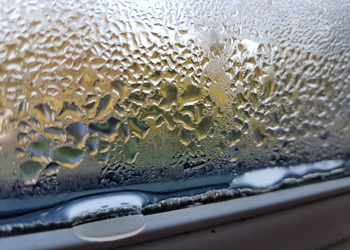What is condensation?
Condensation is the process by which water vapour in the air is changed into liquid water. The air contains moisture in varying quantities. Its capacity to hold the moisture is determined by its temperature. Warm air can hold more moisture than cold air.
When warm, moist air comes into contact with a colder surface or air, the warm air cools down and is unable to retain the same amount of moisture and the water is released forming condensation. The condensed water usually appears as water droplets on surfaces such as windows, walls or tiles. This excess moisture can lead to damp problems such as mould. Condensation can easily go unnoticed until black mould growth or rotting of material appears.

For example, when the warm steam from your hot shower comes in contact with the surface of the cold mirror, the water vapour condenses, or turns into its liquid form. You will notice it as moisture or beads of water formed on the mirror.
Condensation is a common problem for many landlords. If undetected, it can result in damage to furniture, mould growth, mite infestation, unhealthy living conditions and poor indoor air quality.
What causes condensation?
How to prevent condensation?
How to control condensation?
Recommended Services
Mould Treatment
Condensation & Mould Surveys
Ventilation Installation
Ventilation Servicing





